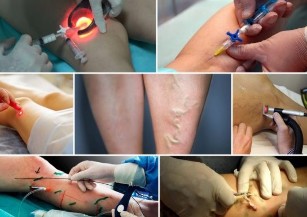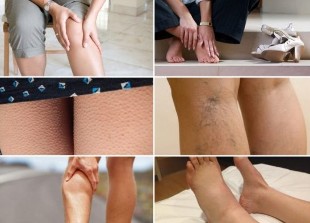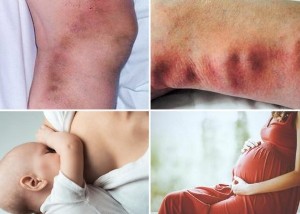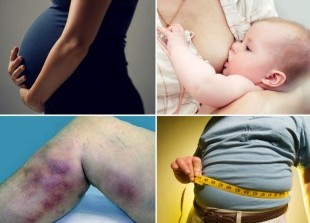Varicose veins of legs is known to people for a very long time: this diagnosis to their patients even "fathers" of modern medicine: Hippocrates, Galen and Paracelsus. But the most widespread disease received in the twentieth century and in the twenty-first, she continues to win new positions: according to the world health organization, in our days the signs of disease in varying degrees, have 66% of men and more than 80% of women living in developed countries. The predominance of female employees over male due to the fact that nature is laid on the weaker sex the responsibilities for bearing and birth of children and also the passion of the beautiful half of humanity to elegant high heel shoes. Modern methods of treatment of varicose veins of the lower limbs allow you to alleviate the condition without resorting to complex surgical intervention.

Why you should treat varicose veins
Varicose veins – a disease of people "standing" professions: sellers, hairdressers, workers behind the machine, surgeons and those whose professional duties require prolonged static load on the lower limbs. In conditions of static load are weakened venous valves governing the inflow and outflow of blood in this area of the body. As a result, the blood in the veins stagnates and thickens, stretching and deforming the walls of blood vessels – are prerequisites for the emergence of varicose veins.
The process is slow, and at first the sick man believes that he had no varicose veins on the legs, if he does not see a strong swelling and protruding under the skin bumpy strands. But this pattern is only characteristic for an advanced stage when the only means to restore a normal appearance of the lower limbs becomes a surgical scalpel. However, the main danger of varicose veins is not that of feet hurt, swell and lose their appeal, covered with knotted vessels, protruding above the surface of the skin.
Causing stagnation of blood flow, varicose veins causing the blood vessels of the legs blood clots – dense clots composed of erythrocytes (blood cells). Over blood clots spread throughout the body, penetrate the lungs, heart, brain, blocking the blood vessels supplying them with blood and leading to thromboembolism – blockage of the vascular lumen, which may become severe pathology:
- Myocardial infarction – death of tissue of the heart muscle due to lack of blood supply;
- Stroke – acute impairment of cerebral circulation that leads to the death of brain cells;
- Gangrene – tissue necrosis.
Attention!
Any of the diseases described above, has the effect of at least severe disability, with a maximum of death. So start varicose veins impossible in any case.
To go to the doctor the patient should at the first signs of the disease:
- Fatigue legs;
- Pulling pain in the legs, especially at the end of the day, or after exercise;
- Tingling the leg it's like "spent";
- Small spider veins and "spider veins" on the surface of the skin of the feet;
- Cramps leg muscles (usually at night);
- Swelling of legs.

If timely measures adopted modern methods of treatment of varicose veins on the legs prevent disease progression and reverse the process. Now it can be done without resorting to highly traumatic surgical operations, which were previously the only way to solve the problem. Doctors there are many treatment procedures for varicose veins, able to provide the patient the possibility of returning to normal life.
Methods of treatment of varicose veins
Often patients suffering from advanced form of varicose vessels of the legs, especially women, afraid of the operation and remaining after her scars, pulled the doctor to the last, bringing the situation to the extreme. However, medicine, like all other disciplines, constantly evolving and daughters and grandchildren will not have to fear that the varicose veins will be treated the same way as their mothers and grandmothers. The experts have invented many effective therapeutic techniques – bezoperatsionnaya or so-called minimally invasive, i.e. does not require deep surgery. Among them the most popularity of procedures such as:
- Sclerotherapy;
- Laser treatment;
- Radiofrequency ablation of the veins;
- Microphlebectomy.
Each of these methods of treatment of varicose veins modern methods I should tell more.
Sclerotherapy
For procedures performed at the stage of varicose veins when the affected vein is superficial, but not deep affected, the drug, called sclerosant, is injected into the affected varicose vein. This is done using a syringe or micro-catheter – a thin tube, the diameter of which is less than the cross-section of a human hair, which the doctor pierces the skin in the place where there is a noticeable affected by the varicose vessel. The manipulation does not cause unpleasant sensations, sometimes accompanied by a feeling of light burning. Glue Sclerosant to the vein wall from the inside, bringing her out of the circulatory system, as a result, she shrinks, diminishes and ceases to worry the patient, disappearing from the surface of the skin. Therefore, when using the method is not only therapeutic, but also cosmetic effect.

The procedure lasts about half an hour, during which the doctor makes several injections into a vein through punctures in the skin. Usually treatment by the method of sclerotherapy is not more than three such procedures, but sometimes, focusing on the condition of the patient, the doctor decides to increase their number. From one to another visit to the doctor should be at least a week.
Before the visit to the doctor, the patient must take a shower and within 2 days before and 2 days after you comply with certain restrictions to guarantee the success of treatment by this method:
- Do not smoke and do not drink alcohol;
- To stop taking blood-thinning medications;
- Not to do hair removal not to apply to the skin cosmetic products;
- Not to come to the office hungry – should eat for half an hour before the procedure.
Complications in the result of the method of sclerotherapy is not usually arise, but is sometimes observed:
- Itching at the injection site, which subsides after 2 hours after injection;
- The pain can last up to three days;
- The peeling of skin stops after 10-12 days.
Extremely rare (1 in a thousand) there may be inflammation of the veins – thrombophlebitis.
At the end of the course of treatment with this method you need to:
- During the week to avoid the strengthened load on the legs.
- Two weeks is not to take a hot bath and a hot shower;
- Two and a half months not to go to the bath;
- Do not sit or stand for long periods of time.
Important!
Procedure sclerotherapy must hold a professional doctor, so you need to seek help only in specialized medical institutions. Upon completion of the course, you need medical supervision during the month.
Laser
Laser therapy is another method of treating varicose veins without surgery. Among its advantages are the following:
- Vein treatment laser beam does not require any incisions and leaves no traces on the skin surface of the feet;
- The process is virtually painless – quite shallow local anesthesia;
- The procedure takes only a few minutes;
- The patient's recovery after such a bloodless surgery is very fast.

The laser unit generates radiation of waves of a certain length, which, passing through the venous blood, generates heat and "seals" the diseased vessel from inside. As a result, he is excluded from blood flow and blood circulation continues in the deep veins and collateral – small side vessels. Taking the load, they begin to develop and some days reach the size of a remote vessel.
The procedure is performed under local anesthesia by injecting into the vein through a puncture in the skin of the feet laser light guide at the tip which has a microscopic lens, ensuring the beam distribution for a uniform coagulation (sealing) of Vienna. Manipulation runs for 30 minutes, after which the patient can immediately return to normal life.
Contraindications to the use of treatment of varicose veins with laser treatment are pregnancy and lactation. The procedure is contraindicated during exacerbation of comorbidities, tendency to form blood clots, inflammation of the skin in the area of laser application, low blood clotting.
Radiofrequency ablation
This non-surgical method of treatment of varicose veins of the lower limbs began to be used relatively recently – only about ten years ago. It is widespread in the United States and Western Europe, in Russia the same method were three years ago, and while used infrequently. The main reason is the high cost of the equipment necessary for examination and therapy.

This procedure gives a wonderful effect in the treatment of varicose veins in the legs. It appreciate both practitioners and patients. The method is largely similar to the laser through an incision in the skin, the doctor inserts the patient into the lumen of the vessel RF waveguide that seals the vessel by radiation of radio waves. Excluded from the bloodstream Vienna with time is replaced by connective tissue. Contraindications, other than those specified for the laser treatment, is a patient of the atherosclerosis and severe degrees of obesity.
The positive side of using the method compared to conventional surgery for varicose veins of the legs are:
- Much less negative feelings of the patient.
- A strong performance is a positive effect of the method lasts for several years.
- Low probability of complications – according to statistics, they occur in only three patients out of a hundred who underwent the procedure.
Important! Very important is the expertise of the doctor performing the manipulation for this method. The patient is recommended to pay special attention to this aspect of the issue before treatment.
Micro-phlebectomy
This is another advanced minimally invasive procedure, which is a microsurgical procedure in which the doctor removes the diseased vessel under the skin through a microscopic incision using a special hook. Next, the affected varicose veins the area is cut off and the healthy part of the vessel are stitched together.
After surgery on the patient's skin are very small scars that are impossible to see with the naked eye. Sometimes the incision appears hematoma, which disappears within two weeks. During the recovery period (1-2 months – specific dates depend on the number of operated veins), the patient must wear a compression garment and to avoid strenuous exercise. The rest of the patient undergoing surgery, one can lead normal way of life.
Provided timely assistance, the modern medicine offers many ways to treat varicose veins on the legs, allowing to solve this problem with minimal damage to the patient. Make the right choice of method the patient will help the physician after appropriate surveys.












































